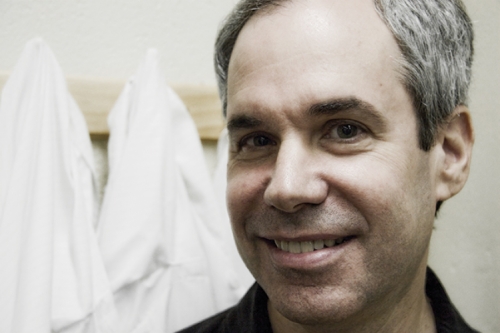In 1922, a team lead by Howard Carter discovered the tomb of Tutankhamun. A few months later, one of the men died of a fever. When other members of the team also died, people blamed a curse.
But some scientists, including microbiologist Bill Goldman, suspect that the real cause was histoplasmosis.
Histoplasma capsulatum, a fungus, lives in the ground. In parts of the Ohio and Mississippi river valleys, where the soil is loaded with histoplasma, nearly 90 percent of residents test positive for having been infected — meaning that at some point they’ve breathed in the germ.
Bill Goldman knows all about it. “I grew up in St. Louis and on my chest x-ray it looks like I’ve had tuberculosis, but it was really histoplasmosis,” he says. It’s common for histoplasmosis to be mistaken for TB, a cold, or the flu. It can cause coughing, fatigue, and fever, just like lots of other respiratory diseases, so most people never even know that they’ve had it.
Histoplasma are a special kind of fungus: they’re dimorphic, meaning that they can grow in two forms. In the soil, histoplasma grow like mold. When the soil is dug up and disturbed, it releases the mold into the air. If inhaled, the histoplasma start growing like yeast, replicating rapidly in the lungs.
Histoplasma are special for another reason. While most fungi only cause disease in people with weakened immune systems, this fungus makes perfectly healthy hosts sick. In 1997 a histoplasma infection landed Bob Dylan in the hospital for weeks. He was so sick that Newsweek ran two cover stories about his illness. The first was titled “Death Scare,” and the second, “Dylan Lives.” Johnny Cash even referenced the disease in his song “Beans for Breakfast.”
But Dylan and Cash and the Pharaoh’s curse didn’t get Goldman into studying histoplasma. It was because there are about 250,000 cases of histoplasmosis in the United States every year, and, as Goldman explains, it’s one of the most widespread respiratory fungal diseases in the world.
Good at hiding
One of the reasons histoplasma are so successful is their ability to hide. “We wrote an article about histoplasma called ‘Fungal Stealth Technology,’” Goldman says. “The cover art had fungi dressed up as ninjas, sneaking up on cells.” Once inhaled by a person, the fungi find the perfect hiding place: inside immune cells in the lung.
These cells, called macrophages, are normally our first line of defense against bacterial and fungal invaders. Macrophages destroy germs by digesting them into bits recognizable to the rest of the immune system. But histoplasma can take control of the weapons that macrophages use against them. What’s more, histoplasma can hide in cells for decades after the infection, living inside the macrophage in little bags made of cell membrane. “Later, even years later, they can reactivate and make you sick,” Goldman says.
Goldman and his lab wanted to find out what makes histoplasma so good at being bad. They knew that mold histoplasma use one set of genes to survive in the soil, and another to survive as yeast in human cells. In the late 1990s, Goldman’s team discovered a small calcium-binding protein (CBP) that was made only by the yeast form of histoplasma. And the yeast made a lot of this protein — in fact, the CBP gene is one of the most active genes in the whole germ.
Goldman recognized that the histoplasma were expending lots of energy to make and release whopping amounts of this protein, so he figured that CBP must be important for the yeast to survive and spread in the host. He was right. When his lab members disrupted the gene for CBP in histoplasma, the yeast could no longer cause disease.
But what CBP did, other than pick up calcium, remained a mystery. Scientists usually get an idea of what a gene or protein is up to by comparing its sequence to other known genes and proteins in a huge database maintained by the National Institutes of Health. But the CBP sequence was unique.
Goldman and his lab decided that what they really needed was a picture of CBP. They used a technique called nuclear magnetic resonance. When certain types of molecules are exposed to magnetic fields, they give off an energy signature that can be translated into a visual image of the molecule. The technique allows scientists to see what a protein structure looks like. And form often dictates function.
When they compared the 3-D structure of CBP to the published structures of other proteins, they were amazed to discover CBP looked just like saposin B, a protein made in the human body. “In terms of the structure, the size, the detail, and how the bonds are formed, it was nearly identical,” Goldman says.
But what is saposin B? In mammals, it helps maintain cell membranes such as the ones that form hiding places for histoplasma inside macrophages. But the protein also helps the immune system recognize bits of germs that are in places where they don’t belong.
Goldman and his team still don’t fully understand what CBP is doing, but they now have some hypotheses to test. One idea is that histoplasma make so much CBP that the protein outnumbers naturally occurring saposin B in the cell. By taking over for the human protein, CBP might interfere with how the infected macrophages alert the rest of the immune system, allowing the fungus to remain undetected. So what now? Goldman says they’ll keep digging.
“There’s a lot more we don’t know about the organism and what it has to do to make people sick,” he says. “We’ve found a very good set of clues, and a good set of mysteries.”
Jessica McCann was a student who formerly contributed to Endeavors.
Bill Goldman is chair of the Department of Microbiology and Immunology in the School of Medicine. His research is funded by the National Institutes of Health.



